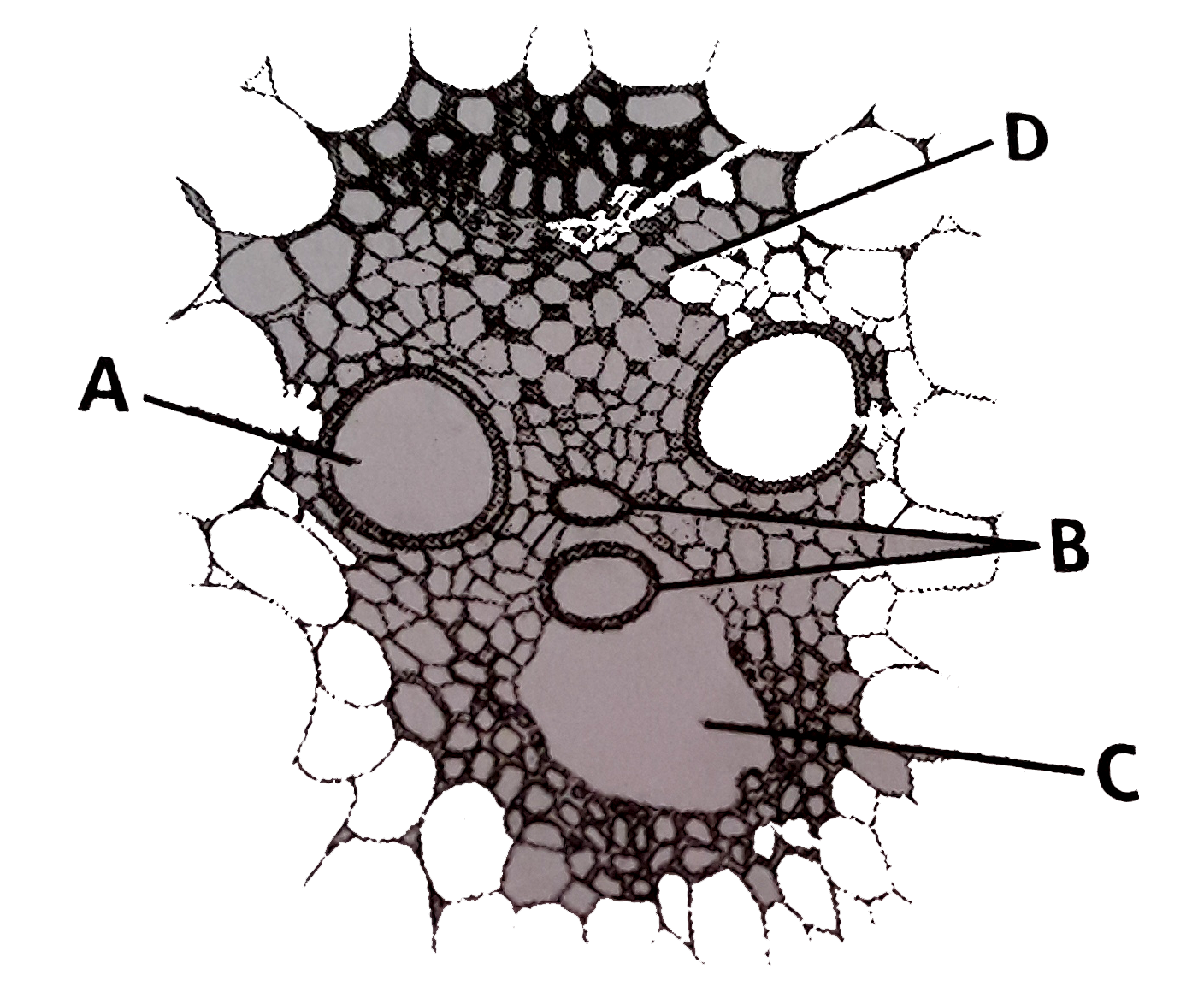Explain various parts in T.S. of a monocot root.
To explain the various parts in the transverse section (T.S.) of a monocot root, we can break it down into several key components:
1. Epidermis:
- The outermost layer of the monocot root is the epidermis. It consists of a single layer of barrel-shaped cells.
- These cells have a peripheral cytoplasm, a large nucleus, and a prominent vacuole.
- Root hairs, which are unicellular, soft, and unbranched, emerge from the epidermis to increase surface area for water and nutrient absorption.
Hint: Remember that the epidermis is the protective outer layer and is crucial for absorption.
2. Cortex:
- Beneath the epidermis lies the cortex, which is made up of loosely packed cells.
- These cortical cells have a lot of intercellular spaces, allowing for gas exchange and storage of substances.
Hint: The cortex serves as a storage area and helps in the transport of water and nutrients.
3. Endodermis:
- The innermost layer of the cortex is the endodermis.
- In monocots, the endodermis is smooth and consists of two to three layers of cells.
- It features suberin strips on the radial and tangential walls, which regulate the movement of water and nutrients into the vascular system.
Hint: The endodermis acts as a selective barrier for substances entering the vascular system.
4. Pericycle:
- Just inside the endodermis is the pericycle, which consists of parenchyma cells.
- This layer can give rise to lateral roots and plays a role in the growth of the root.
Hint: The pericycle is important for root development and can help in forming new roots.
5. Vascular Bundles:
- The vascular bundles in monocot roots are arranged radially, meaning xylem and phloem are located at different radii.
- The xylem is located towards the inside and consists of protoxylem (smaller elements) on the outer side and metaxylem (larger elements) on the inner side.
- The phloem is located on the outer side of the xylem, and the arrangement is polyarc, meaning there are multiple vascular bundles.
Hint: The arrangement of xylem and phloem is crucial for the efficient transport of water, nutrients, and food.
6. Pith:
- The central region of the monocot root is the pith, which is large and well-developed.
- Unlike dicots, monocots do not undergo secondary growth, and thus, there is no cambium present.
Hint: The pith serves as a storage area and is important for the overall structure of the root.
Summary:
In summary, the transverse section of a monocot root consists of the epidermis, cortex, endodermis, pericycle, vascular bundles, and pith. Each part has specific functions that contribute to the overall health and efficiency of the root system.
- The outermost layer of the monocot root is the epidermis. It consists of a single layer of barrel-shaped cells.
- These cells have a peripheral cytoplasm, a large nucleus, and a prominent vacuole.
- Root hairs, which are unicellular, soft, and unbranched, emerge from the epidermis to increase surface area for water and nutrient absorption.
- Beneath the epidermis lies the cortex, which is made up of loosely packed cells.
- These cortical cells have a lot of intercellular spaces, allowing for gas exchange and storage of substances.
- The innermost layer of the cortex is the endodermis.
- In monocots, the endodermis is smooth and consists of two to three layers of cells.
- It features suberin strips on the radial and tangential walls, which regulate the movement of water and nutrients into the vascular system.
- Just inside the endodermis is the pericycle, which consists of parenchyma cells.
- This layer can give rise to lateral roots and plays a role in the growth of the root.
- The vascular bundles in monocot roots are arranged radially, meaning xylem and phloem are located at different radii.
- The xylem is located towards the inside and consists of protoxylem (smaller elements) on the outer side and metaxylem (larger elements) on the inner side.
- The phloem is located on the outer side of the xylem, and the arrangement is polyarc, meaning there are multiple vascular bundles.
- The central region of the monocot root is the pith, which is large and well-developed.
- Unlike dicots, monocots do not undergo secondary growth, and thus, there is no cambium present.
In summary, the transverse section of a monocot root consists of the epidermis, cortex, endodermis, pericycle, vascular bundles, and pith. Each part has specific functions that contribute to the overall health and efficiency of the root system.
Topper's Solved these Questions
- BOOK - ICSECHAPTER - ANATOMY OF FLOWERING PLANTS - PLANT TISSUESEXERCISE - REVIEW QUESTIONS (SHORT ANSWER TYPE QUESTIONS)40videos
ANATOMY OF FLOWERING PLANTS - PLANT TISSUES
- BOOK - ICSECHAPTER - ANATOMY OF FLOWERING PLANTS EXERCISE - Ncert Exercises (Differentiate Between )23videos
ANATOMY OF FLOWERING PLANTS
- BOOK - ICSECHAPTER - ANIMAL KINGDOMEXERCISE - Ncert Exercises (Differentiate between )11videos
ANIMAL KINGDOM
Similar Questions
Knowledge Check
- Question 1 - Select One

Refer to the given figure which represents a section of vascular bundles as seen in T.S. of a monocot stem and select the option that correctly labels A, B, C and DAABCDProtoxylem vesselMetaxylem vesselProtoxylem cavityPhloemBABCDProtoxylem vesselMetaxylem vesselMetaxylem cavityPhloemCABCDMetaxylem vesselProtoxylem vesselProtoxylem cavityPhloemDABCDMetaxylem vesselProtxylem vesselProtoxylem cavitySclerenchyma
Monocot root has
View SolutionGive various parts of an enzyme.
View SolutionDraw and label a part of T.S. of a monocot stem. Explain various tissues present in it.
View SolutionVascular tissue of monocot root is
View SolutionExplain various modes of locomotion in protists.
View SolutionList various parts of a pericarp of a fruit.
View SolutionName various parts of a limbic system ?
View Solution

